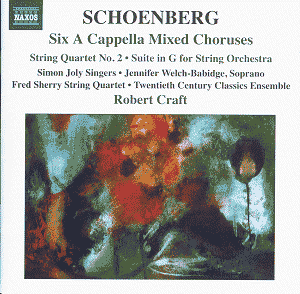Naxos have released
the third volume of their Robert
Craft Collection of the Music of Arnold
Schoenberg, featuring music
composed over a period of forty years.
Craft has recorded a wide range of symphonic,
orchestral, operatic and large ensemble
works including world premières
of pieces by leading 20th-century composers
such as Stravinsky, Berg and Schoenberg.
His musical development was strongly
influenced by Schoenberg and the Second
Viennese School. Amongst his numerous
recordings are a substantial number
of works by Schoenberg including a successful
series for the Koch International Classics
label.
Six A Cappella Mixed Choruses,
Op. 49 (first set 1928 and second set
1948)
In 1928 the ‘State
Commission for the Folksong-Book for
Youth’ in Berlin invited Schoenberg
to harmonize three sixteenth-century
popular German folk-songs. Schoenberg
became deeply absorbed in the work and
created three miniature polyphonic masterpieces.
Twenty years later in Los Angeles he
decided to arrange another three of
these folk-songs in the same style.
The Simon Joly Singers
recorded the Six A Cappella Mixed
Choruses in the Abbey Road studios,
in London. Their excellent singing brings
to these neglected works a special rapturous
glow. There is no evidence in this material
for Schoenberg’s reputation for disruptive
atonality and the singers provide sparkle,
gravity and subtle colours.
String Quartet No. 2 in F sharp major,
Op. 10 (1908)
Schoenberg began the
composition of his second String
Quartet, Op. 10, in Vienna in 1907.
The score is deeply personal and transitionally
experimental composed at a time when
Schoenberg was experiencing distressing
marital difficulties in his life. The
four movements were not written in chronological
order, the first having been composed
more than a year before the others.
The two vocal movements for soprano
Litanei and Entrückung
from texts by Stefan George (1868-1933)
that conclude the quartet signify a
new world in Schoenberg’s musical development.
According to Craft these movements mark
Schoenberg’s greatest advance in harmonic
discovery and sensitivity thus far in
his life: every chord, progression,
combination of pitches, is utterly new
and unerringly right, and the quiet,
deliquescent string introduction to
Entrückung, and the enthralling
combination of voice and quartet throughout
are a peak in early twentieth-century
music. On this recording Craft has decided
to present the String Quartet, op. 10
in its original form and not in Schoenberg’s
1929 String Orchestra version. Craft
considers that the vocal movements contain
some of the most inward Schoenberg ever
wrote.
The Fred Sherry String
Quartet demonstrate that they have full
measure of the fascinating and often
challenging second String Quartet. These
are well-thought out accounts and the
playing in the opening movement allegro
and scherzo is especially
fluent and outgoing. In the third movement
entitled Litanei and the extended
concluding movement Entrückung
the soprano part is confidently sung
by Jennifer Welch-Babidge. Her voice
is strong and firm with a most impressive
focus. The darker colour to her voice
made me wonder if she was actually a
mezzo. The quartet perform with conviction
and a real sense of teamwork.
Suite in G major for String Orchestra
(1934)
Schoenberg was persuaded
by Martin Bernstein, a young double-bass
player from New York University, to
compose a work suitable for music students
and the result was his "Suite
written in the old style for string
orchestra." Composed in the
form of a baroque suite this is
in five movements: Overture, Adagio,
Minuet, Gavotte, and Gigue. Owing to
the relative difficulty of the writing
it is clear that Schoenberg was unaware
of the primitive level of music training
in American institutions at the time.
The first performance was given by the
Los Angeles Philharmonic Orchestra conducted
by Otto Klemperer in 1935. In fact,
Klemperer and his professional players
found the score, that was aimed at students,
extremely difficult to perform. For
this reason it is still, seventy years
later, practically unknown.
The Twentieth Century
Classics Ensemble from New York produce
a wonderfully blended tone. They perform
with a high degree of forward momentum
and considerable spirit which makes
a convincing case for this neglected
score.
The sound quality is
impressive and well balanced, with excellent
booklet notes from Robert Craft.
A thoroughly enjoyable
release which should convert many to
Schoenberg’s music.
Michael Cookson


